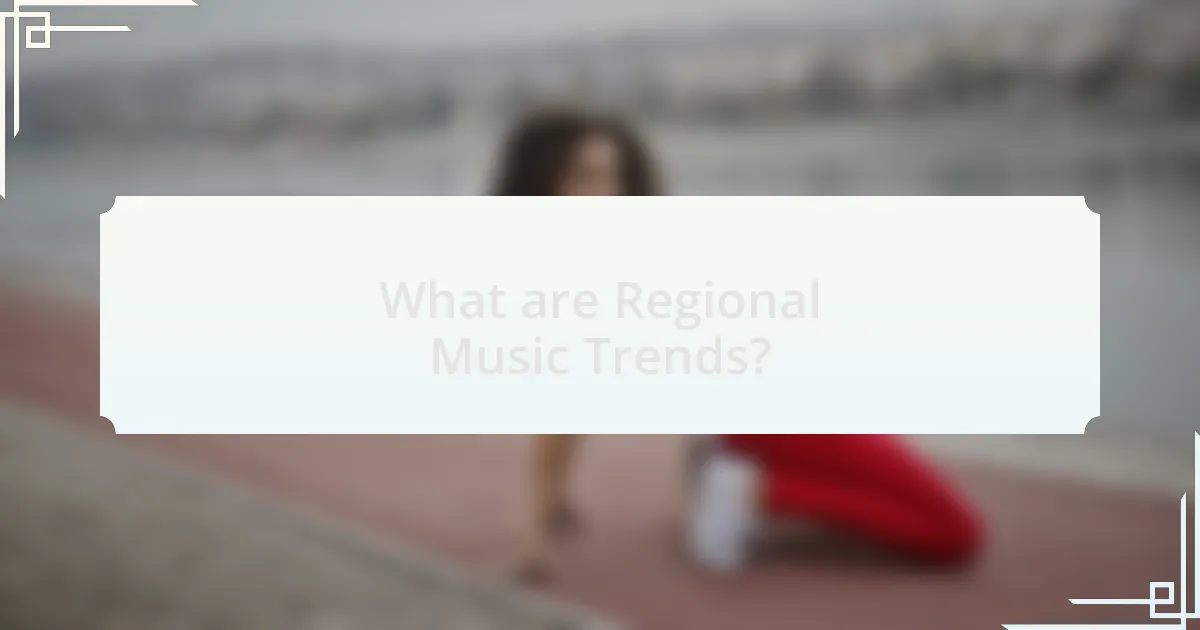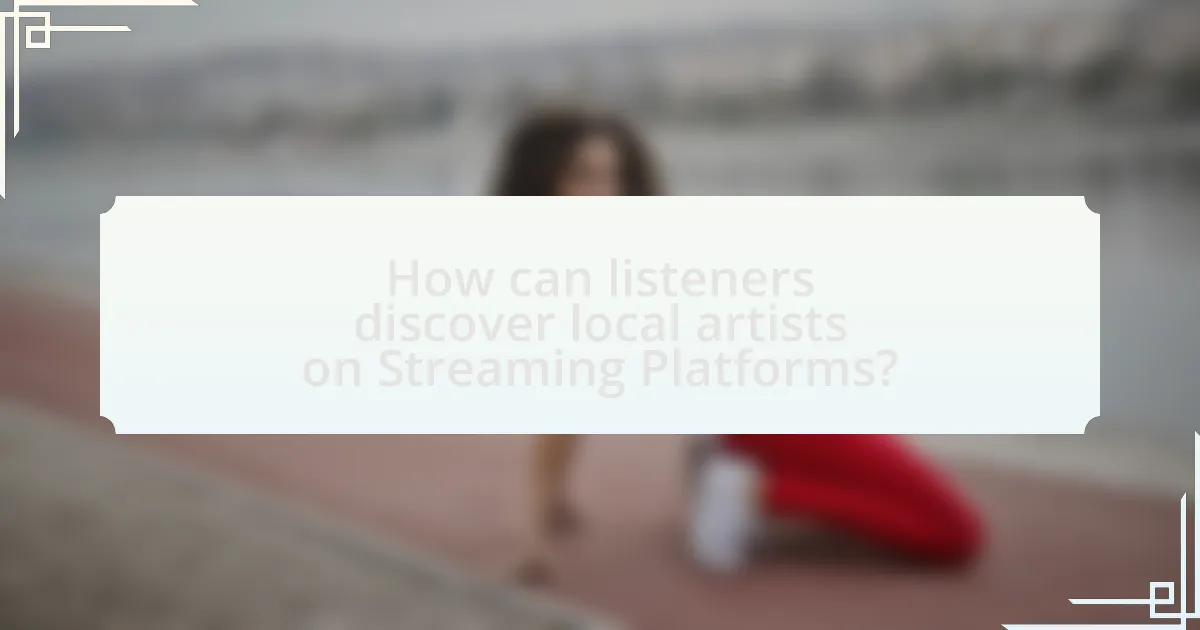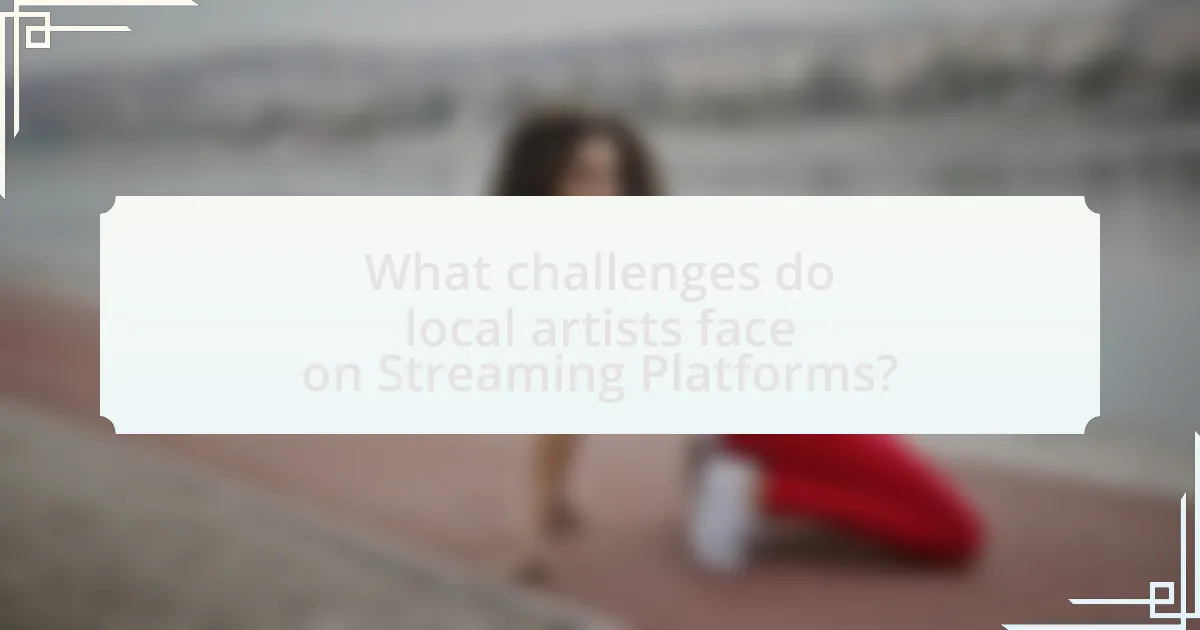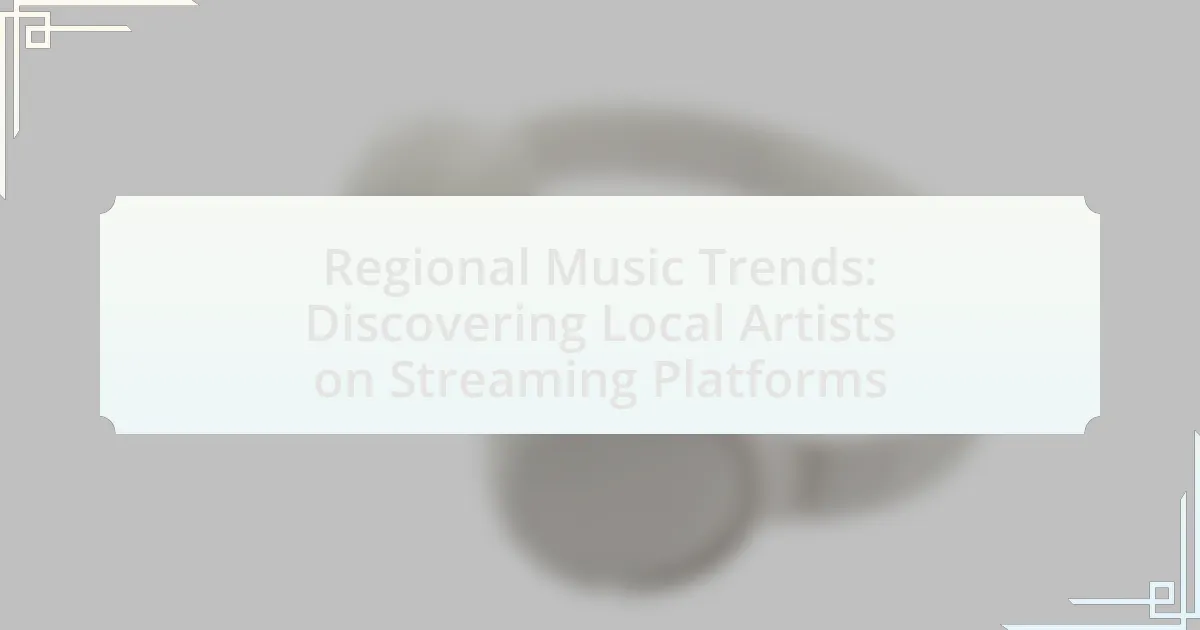Regional music trends encompass the distinct musical styles and genres that arise from specific geographic areas, shaped by local culture and social dynamics. This article explores how these trends influence local artists, the factors contributing to their emergence, and the role of streaming platforms in promoting regional music. It highlights the importance of cultural elements, algorithms, and community engagement in enhancing visibility for local artists. Additionally, the article addresses the challenges faced by these artists on streaming platforms and offers strategies for listeners to discover and support regional talent effectively.

What are Regional Music Trends?
Regional music trends refer to the unique musical styles, genres, and preferences that emerge from specific geographic areas, influenced by local culture, history, and social dynamics. These trends often manifest in the popularity of local artists and genres on streaming platforms, where listeners increasingly seek authentic regional sounds. For instance, the rise of Latin trap in urban areas of Latin America and the U.S. showcases how regional influences shape music consumption patterns, as evidenced by the significant streaming numbers and chart performances of artists like Bad Bunny and J Balvin. This phenomenon highlights the growing importance of regional music in the global music landscape, as local artists gain recognition and audiences through digital platforms.
How do Regional Music Trends influence local artists?
Regional music trends significantly influence local artists by shaping their musical styles, themes, and marketing strategies. Local artists often draw inspiration from the prevailing sounds and cultural narratives within their region, leading to the creation of music that resonates with local audiences. For instance, artists in Nashville typically incorporate elements of country music, reflecting the city’s musical heritage, while artists in New Orleans may blend jazz and blues, showcasing the region’s rich musical history. This alignment with regional trends not only enhances the artists’ authenticity but also increases their visibility on streaming platforms, as algorithms often favor music that aligns with local preferences. Consequently, local artists who adapt to these trends can achieve greater engagement and success within their communities and beyond.
What factors contribute to the emergence of Regional Music Trends?
Regional music trends emerge due to a combination of cultural identity, technological access, and social media influence. Cultural identity shapes musical styles and preferences, as local traditions and languages often inspire artists to create music that resonates with their communities. Technological access, particularly through streaming platforms, allows regional artists to distribute their music widely, reaching audiences beyond geographical boundaries. Social media platforms facilitate the sharing and promotion of regional music, enabling artists to connect with fans and other musicians, thus fostering a collaborative environment that encourages the growth of local music scenes. These factors collectively contribute to the rise and popularity of regional music trends.
How do cultural elements shape these trends?
Cultural elements significantly shape regional music trends by influencing the themes, styles, and popularity of local artists on streaming platforms. For instance, cultural traditions, languages, and social practices inform the lyrical content and musical genres that resonate with specific audiences. A study by the Pew Research Center found that 72% of music listeners prefer songs that reflect their cultural identity, demonstrating how cultural context drives engagement with regional music. Additionally, local festivals and community events often promote regional artists, further embedding cultural elements into the music consumption patterns observed on streaming platforms.
Why are Streaming Platforms important for Regional Music?
Streaming platforms are important for regional music because they provide a global audience for local artists, enabling them to reach listeners beyond their immediate geographical area. This accessibility allows regional music to gain visibility and traction, which is crucial for artists who may not have the resources for traditional marketing. For instance, platforms like Spotify and Apple Music have dedicated playlists for regional genres, showcasing artists to millions of potential fans. Additionally, data from the International Federation of the Phonographic Industry (IFPI) indicates that streaming has become the primary source of music consumption, further emphasizing the role of these platforms in promoting regional music and artists.
How do Streaming Platforms support local artists?
Streaming platforms support local artists by providing them with a global audience and tools for promotion. These platforms often feature local music in curated playlists, which increases visibility and accessibility for regional artists. For instance, Spotify’s “Local” playlists highlight emerging talent from specific areas, allowing listeners to discover new artists. Additionally, platforms like Bandcamp enable artists to sell their music directly to fans, retaining a larger share of revenue compared to traditional distribution methods. According to a 2021 report by the International Federation of the Phonographic Industry, streaming services have significantly contributed to the growth of independent music, with local artists benefiting from increased streaming revenues and audience engagement.
What role do algorithms play in promoting regional music?
Algorithms play a crucial role in promoting regional music by personalizing recommendations based on user preferences and listening habits. Streaming platforms like Spotify and Apple Music utilize algorithms to analyze data from users, which helps in identifying and suggesting local artists and genres that align with listeners’ tastes. For instance, Spotify’s algorithm considers factors such as geographic location, user interactions, and genre popularity to curate playlists that feature regional music, thereby increasing visibility for local artists. This targeted approach not only enhances user experience but also supports the growth of regional music scenes by connecting artists with audiences who are more likely to appreciate their work.

How can listeners discover local artists on Streaming Platforms?
Listeners can discover local artists on streaming platforms by utilizing location-based playlists and curated local music sections. Many streaming services, such as Spotify and Apple Music, feature playlists specifically designed to highlight artists from particular regions, allowing users to explore music that reflects their local culture. Additionally, users can follow local music blogs or social media accounts that promote regional talent, which often link to streaming platforms. According to a 2021 report by the International Federation of the Phonographic Industry, 70% of music listeners are more likely to engage with artists who are geographically relevant to them, reinforcing the effectiveness of these methods for discovering local talent.
What features do Streaming Platforms offer for discovering local music?
Streaming platforms offer features such as location-based playlists, local artist recommendations, and geo-targeted events to help users discover local music. These features utilize algorithms that analyze user location data to curate playlists that highlight artists from specific regions, making it easier for listeners to connect with their local music scene. For instance, platforms like Spotify and Apple Music often create playlists that feature emerging local artists, enhancing visibility and accessibility for regional talent. Additionally, some platforms provide information about local concerts and events, further promoting local music engagement.
How do playlists and recommendations enhance local music discovery?
Playlists and recommendations enhance local music discovery by curating and promoting regional artists to listeners based on their preferences and listening habits. Streaming platforms utilize algorithms that analyze user data to create personalized playlists, which often include local music, thereby increasing exposure for artists within specific geographic areas. For instance, Spotify’s “Discover Weekly” and “Release Radar” playlists frequently feature local musicians, helping them reach audiences who may not have encountered their music otherwise. This targeted approach not only supports local talent but also fosters a sense of community among listeners, as they engage with music that reflects their cultural and regional identity.
What are the benefits of following local artists on these platforms?
Following local artists on streaming platforms provides several benefits, including supporting the local economy and fostering community engagement. By following these artists, listeners contribute to the financial sustainability of their local music scene, which can lead to more live performances and cultural events. Additionally, local artists often reflect the unique cultural narratives and experiences of their communities, allowing listeners to connect more deeply with their regional identity. Research indicates that local music consumption can enhance community and cohesion, as highlighted in studies by the National Endowment for the Arts, which show that local arts participation correlates with increased social interaction and community involvement.
Why is it essential to support local artists?
Supporting local artists is essential because it fosters cultural diversity and strengthens community identity. Local artists often reflect the unique experiences and stories of their communities, contributing to a rich cultural tapestry. According to a study by the National Endowment for the Arts, local arts organizations generate significant economic impact, creating jobs and stimulating local economies. Furthermore, supporting local artists helps sustain creative ecosystems, ensuring that diverse voices are heard and valued in the broader cultural landscape.
How does supporting local artists impact the music community?
Supporting local artists significantly enhances the music community by fostering diversity and innovation. When local artists receive support, they contribute unique sounds and perspectives that enrich the overall musical landscape. This support can lead to increased opportunities for collaboration, performance, and exposure, which in turn strengthens community ties and encourages a vibrant local scene. For instance, a study by the National Endowment for the Arts found that local music scenes can boost local economies by creating jobs and attracting tourism, demonstrating the tangible benefits of investing in local talent.
What are the economic benefits of promoting regional music?
Promoting regional music generates significant economic benefits by enhancing local economies, creating jobs, and fostering tourism. Local music scenes stimulate economic activity through live performances, which attract audiences and generate revenue for venues, artists, and related businesses. For instance, a study by the National Endowment for the Arts found that arts and culture contribute over $877 billion to the U.S. economy, with music being a substantial component. Additionally, regional music festivals can draw tourists, leading to increased spending in hospitality, dining, and retail sectors. This interconnectedness of music and local economies demonstrates that promoting regional music not only supports artists but also bolsters community financial health.

What challenges do local artists face on Streaming Platforms?
Local artists face significant challenges on streaming platforms, primarily due to limited visibility and competition from established artists. The algorithms used by these platforms often favor popular or mainstream content, making it difficult for local artists to gain traction. According to a 2021 report by the International Federation of the Phonographic Industry, over 70% of music streams are dominated by the top 1% of artists, which highlights the disparity in exposure. Additionally, local artists often struggle with monetization, as streaming services typically pay low per-stream rates, making it hard for them to sustain their careers. This combination of algorithmic bias and financial constraints creates a challenging environment for local talent to thrive.
How do competition and visibility affect local artists?
Competition and visibility significantly impact local artists by influencing their market reach and opportunities for success. Increased competition can drive local artists to enhance their creativity and marketing strategies, as they strive to stand out in a crowded field. For instance, a study by the National Endowment for the Arts found that local artists who actively engage in social media and streaming platforms experience higher visibility, leading to increased fan engagement and sales. Conversely, limited visibility can hinder an artist’s ability to gain recognition, making it challenging to attract audiences and secure performance opportunities. Therefore, the interplay between competition and visibility shapes the overall success and sustainability of local artists in the music industry.
What strategies can local artists use to stand out?
Local artists can stand out by leveraging social media platforms to engage with their audience and showcase their unique style. By consistently posting content that reflects their artistic identity, such as behind-the-scenes videos, live performances, and personal stories, artists can build a loyal following. Additionally, collaborating with other local musicians and participating in community events can enhance visibility and create networking opportunities. Research indicates that artists who actively engage with their audience on platforms like Instagram and TikTok see a significant increase in fan interaction and streaming numbers, highlighting the effectiveness of these strategies in the digital age.
How can local artists leverage social media alongside streaming?
Local artists can leverage social media alongside streaming by using platforms like Instagram, Facebook, and TikTok to promote their music and engage with their audience. By sharing behind-the-scenes content, live performances, and personal stories, artists can build a loyal fanbase that translates into streaming numbers. For instance, a study by the International Federation of the Phonographic Industry (IFPI) found that 70% of music listeners discover new artists through social media. This demonstrates the effectiveness of social media in driving traffic to streaming platforms, where artists can monetize their music. Additionally, artists can collaborate with influencers to reach wider audiences, further enhancing their visibility and streaming potential.
What are the best practices for discovering and supporting local music?
The best practices for discovering and supporting local music include actively engaging with local music scenes, utilizing streaming platforms that feature regional artists, and attending live performances. Engaging with local music scenes can involve visiting local venues, participating in community events, and following local music blogs or social media pages that highlight emerging artists. Streaming platforms like Spotify and Apple Music often have curated playlists that focus on local talent, making it easier for listeners to find and support these artists. Attending live performances not only provides direct support to musicians but also fosters a sense of community and connection among fans. According to a report by the Music Industry Research Association, local music events contribute significantly to community engagement and artist visibility, reinforcing the importance of these practices in promoting local music.
How can listeners engage with local artists effectively?
Listeners can engage with local artists effectively by attending live performances and participating in community events. Engaging in these activities allows listeners to experience the artists’ work firsthand and fosters a personal connection. Additionally, listeners can support local artists by sharing their music on social media platforms, which increases visibility and helps build a fan base. According to a study by the National Endowment for the Arts, community engagement in the arts enhances local cultural identity and strengthens community ties, demonstrating the impact of listener involvement on local artists’ success.
What resources are available for promoting regional music?
Various resources are available for promoting regional music, including social media platforms, local music festivals, and streaming services. Social media platforms like Instagram and Facebook allow artists to connect with audiences and share their music directly. Local music festivals provide opportunities for artists to perform live and gain exposure within their communities. Streaming services such as Spotify and Apple Music often feature regional playlists that highlight local talent, increasing visibility. Additionally, community radio stations can play a crucial role in promoting regional music by featuring local artists in their programming. These resources collectively enhance the reach and recognition of regional music.

Leave a Reply